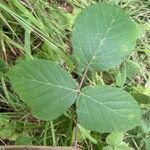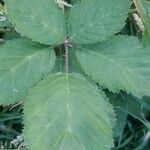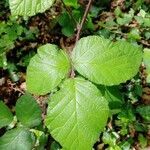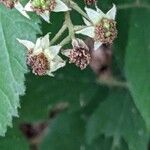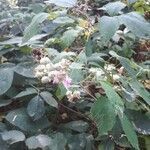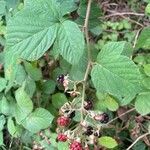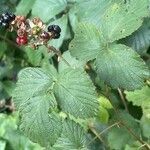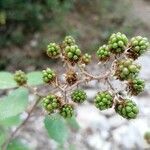Shrubs, 10–20 dm, armed. Stems ?biennial?, arching, usually densely, sometimes moderately, hairy, usually eglandular, sometimes sessile-to short-stipitate-glandular, not pruinose; prickles moderate to dense, recurved to erect, slender, 3–10 mm, broad-based. Leaves deciduous or ± persistent, palmately compound; stipules filiform to linear, 5–15 mm; leaflets 3–5, terminal usually suborbiculate to orbiculate, sometimes broadly elliptic, 4–9 × 4–8 cm, base rounded to shallowly cordate, unlobed, margins moderately to coarsely serrate, apex acute to cuspidate, abaxial surfaces with hooked prickles on midvein, densely white-gray to gray-green tomentose, eglandular or obscurely short-stipitate-to sessile-glandular along midveins. Inflorescences terminal, 7–35-flowered, cymiform or thyrsiform. Pedicels: prickles moderate to dense, recurved to erect, densely hairy, moderately to densely stipitate-glandular. Flowers bisexual; petals pink to magenta, elliptic to suborbiculate, 6–12(–15) mm; filaments filiform; ovaries apically hairy. Fruits black, globose, 1–1.5 cm; drupelets 15–40, coherent, separating with torus attached. 2n = 28.
More
Semi-erect, scrambling shrub; primocanes arching, dark-purple, sharply angled and ± flat between, with numerous subsessile glands, few long-stalked glands and moderately to densely clothed in mostly stellate hairs; armature of many, stout, erect prickles mostly on angles and usually a few pricklets on faces and angles. Young stems densely hairy and glandular. Leaflets (3)-5, sparsely pilose on upper surface, pilose on veins and tomentose (often densely) between on lower surface, irregularly serrate-dentate; terminal leaflet lamina orbicular to broadly elliptic-obovate, acuminate, 60-90-(110) × 50-80-(110) mm with petiole 1/4-3/7 length of lamina. Stipules linear. Infl. densely hairy, with subsessile and many but not numerous long-stalked glands. Sepals long-attenuate, tomentose and with longer simple hairs, with pricklets. Petals rounded or slightly notched, undulate, pale to deep pink. Anthers glabrous or with 1-2 hairs.
